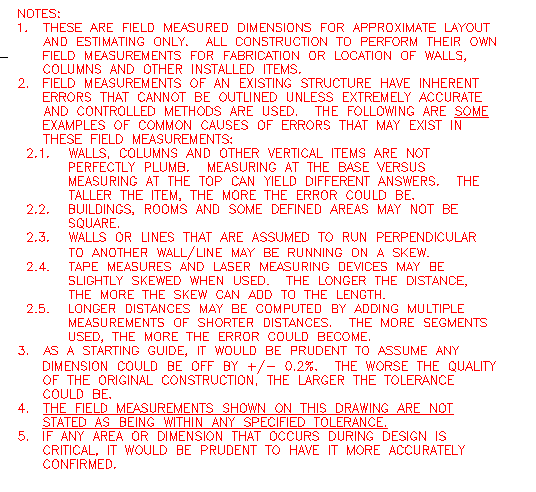This note is when I have been paid to field measure a building for someone. The results may be used by an Architect, Owner, Engineer or Contractor. I have done this before if someone is willing to pay my hourly engineering rate. I have a lesser note when I do the measuring for a structural design I am doing. In this case, it is a little of both. We kept finding big errors in the original field measurements. The building is 18" longer than the previous measurements.
CANPRO said:
but feel almost like you're holding the contractors hand
That is what I am mostly doing. The good ones know how to measure, the bad ones don't. Problem is I am seeing more bad ones. I have the note now where I can delete some bullets if I want to per job but liability is an issue.
JLNJ-I also prefer your suggestion of field determine versus field verify my potential screw-ups.
NOTES:
1. ALL DIMENSIONS SHOWN ON PLANS ARE TAKEN FROM OTHER SOURCES SUCH AS ORIGINAL PLANS, FIELD MEASUREMENTS OR APPROXIMATIONS. THESE DIMENSIONS ARE FOR APPROXIMATE LAYOUT AND ESTIMATING ONLY. DESIGN PROFESSIONALS AND CONTRACTORS TO INDEPENDENTLY FIELD DETERMINE ALL NECESSARY DIMENSIONS FOR ANY ITEM DESIGNED, FABRICATED, SUPPLIED AND/OR INSTALLED BY THEM.
2. DESIGN PROFESSIONAL OR CONTRACTOR TO NOTIFY OWNER, ARCHITECT AND/OR ENGINEER OF DISCREPANCIES BEFORE BEGINNING THE WORK.
3. IF ANY AREA OR DIMENSION THAT OCCURS DURING DESIGN IS CRITICAL, THE DESIGN PROFESSIONAL, SUPPLIER OR CONTRACTOR IS RESPONSIBLE FOR DETERMINING THE DIMENSIONS OR CONDITIONS.
4. DESIGN PROFESSIONALS AND CONTRACTOR SHALL BE RESPONSIBLE FOR FITTING OF NEW WORK TO EXISTING WORK.
5. THE DIMENSIONS SHOWN ON THIS DRAWING ARE NOT STATED AS BEING WITHIN ANY SPECIFIED TOLERANCE.
6. FIELD MEASUREMENTS OF AN EXISTING STRUCTURE HAVE INHERENT ERRORS THAT CANNOT BE OUTLINED UNLESS EXTREMELY ACCURATE AND CONTROLLED METHODS ARE USED. THE FOLLOWING ARE SOME EXAMPLES OF COMMON CAUSES OF ERRORS THAT MAY EXIST IN THESE DIMENSIONS OR FIELD MEASUREMENTS:
6.1. WALLS, COLUMNS AND OTHER VERTICAL ITEMS ARE NOT PERFECTLY PLUMB. MEASURING AT THE BASE VERSUS MEASURING AT THE TOP CAN YIELD DIFFERENT ANSWERS. THE TALLER THE ITEM, THE MORE THE ERROR COULD BE.
6.2. ITEMS MAY BE BOWED OR SAGGED AND THEREFORE MEASURE INCONSISTENTLY ALONG THEIR LENGTH.
6.3. BUILDINGS, ROOMS AND SOME DEFINED AREAS MAY NOT BE SQUARE.
6.4. WALLS OR LINES THAT ARE ASSUMED TO RUN PERPENDICULAR TO ANOTHER WALL/LINE MAY BE RUNNING ON A SKEW.
6.5. TAPE MEASURES AND LASER MEASURING DEVICES MAY BE SLIGHTLY SKEWED WHEN USED. THE LONGER THE DISTANCE, THE MORE THE SKEW CAN ADD TO THE LENGTH.
6.6. LONGER DISTANCES MAY BE COMPUTED BY ADDING MULTIPLE MEASUREMENTS OF SHORTER DISTANCES. THE MORE SEGMENTS USED, THE MORE THE ERROR COULD BECOME.
7. A MORE ACCURATE ASSESSMENT OF THE EXISTING BUILDING DIMENSIONS CAN BE PROVIDED AT AN ADDITIONAL FEE. THE MORE STRINGENT THE REQUESTED TOLERANCES ARE, THE MORE THE FEE WOULD BE.


